Petrography and Geochemistry of the Li-F Granites and Aplite-Pegmatoid Banded Rocks of the Orlovka and Etyka Tantalum Deposits in the East Transbaikalia
G.P. Zaraisky*, R. Seltmann**, V.V. Shatov***, A.M. Aksyuk, Yu.B. Shapovalov*,
And V.Yu. Chevychelov*
* Institute of Experimental Mineralogy (IEM), Chernogolovka, Moscow District, Russia
** GeoForschungZentrum (GFZ), Potsdam, Germany
*** All-Russia Geological Research Institute (VSEGEI), St. Petersburg, Russia
Previously published in: Mineral Deposits: Research and Exploration Where do They Meet? Proceedings of the Fourth Biennial SGA Meeting , Turku/Finland/11-13 August 1997. Heikky Papunen (ed.), A.A. Balkema, Rotterdam, Brookfield, 1997, pp.695-698.
ABSTRACT: The Orlovka and Etyka Ta deposits are related to late Jurassic subalkali peraluminous Li-F amazonite granites. There are the peculiar rhythmic-banded aplite-pegmatoid rocks which form flat lenses in apical part of the granite cupolas. The fine-grained aplite quartz-albite, quartz-microcline (amazonite), and quartz-mica layers alternate with the coarse-grained quartz-amazonite pegmatoid layers in the banded bodies. The major and the trace elements are nonuniformly participated between the different layers. The alternated layers have the complementary chemical composition and as a whole correspond to the parent Li-F granite. The layering could be caused by an oscillation of physico-chemical parameters during fractional crystallization of the volatile saturated residual Li-F melt. Metasomatic effects on the formation of the layered rock were restricted.
1. Introduction
The Orlovka and Etyka tantalum deposits are located in the East Transbaikalia 140 and 250 km to SE of Chita, respectively. The Ta-Nb mineralization is confined to apical parts of the cupolas of the Li-F amazonite granite. Presence of amazonite and specific rhythmic-banded granitic rocks constituted by quartz-albite, quartz-microcline (amazonite), and quartz-mica layers with aplite or pegmatoid texture are typical for both Orlovka and Etyka deposits. We keep in mind that pegmatoid is the pegmatite-like rock without micrographic texture as usual. The layered rocks form subhorizontal layers or flat lenses in the massive rare-metal granites. The thickness of the rhythmic-layered bodies varies from 10 cm to 1-1.5 m and the length is up to several tens of meters. In addition to the prevailing horizontal layers occur steeply dipping dike-like rhythmic-banded bodies. Both rhythmic-banded rocks and tantalum mineralization are located in the granite cupolas only to the depth of 30-50 m from the schist roof. It may be assumed that the formation of banded bodies in the granite cupolas is genetically associated with the Ta-Nb mineralization and related to the magmatic-hydrothermal transition processes. However, the physico-chemical conditions and mechanism of formation for such banded bodies are as yet imperfectly undressed. The mineral and chemical compositions of the layers are also insufficiently studied. To fill up the gap the 75 representative rock specimens of the parent granites, schist of roof, and the individual layers of the banded rocks were taken from the Orlovka and Etyka deposits. These specimens were investigated with microscope MIO - 5 for estimation of quantitative mineral compositions. The chemical composition was analyzed by XRF, DC arc spectrometry, ion selective, AAS, and wet chemical methods (Table 1).
2. Geological setting of the deposits
Both deposits are confined to the apical and endocontact parts of small Li-F granite intrusives of late Jurassic age. The host rocks in both cases are early Mesozoic metaterrigenous series. The tantalum minerals are represented by fine-disseminated (0.01-1 mm) tantalite, tantalite-columbite, microlite, and pyrochlore enriching the endocontact rocks of the granite cupolas (Rare Metal..., 1995).
According to (Beskin et al., 1994a) the Orlovka tantalum-bearing Li-F granite forms a small flat body of 1.2-1.5 km2 in square and 0.3-0.4 km in thickness. The Khangilai subalkali leucogranite pluton is in size 20x18x6-8 km by gravimetric data. It underlies the Orlovka ore-bearing amazonite granite. The Khangilai granite is exposed to the east of Orlovka as an elongated dome of 8 km2 in size. Triassic schist and sandstone make up the roof of the Orlovka granite. The age of the Orlovka granite is determined by Rb-Sr isotope method as 141.5± 2.8 (Negrei et al., 1995).
The Etyka massif of tantalum-bearing Li-F granites is a flat laccolite of 1.5-2 km in diameter decreased drastically after the 500 m depth (Beskin et al., 1994b). The massif is located in the upper part of the underlied Oldanda subalkali granite pluton of 25x20 km in size. The Oldanda pluton is exposed 5 km to the south of Etyka. The early Jurassic argillite-aleurolite formation is a roof of the granite. Both the Orlovka and Etyka tantalum-bearing Li-F granites are later than the underlying the biotite leucogranites of the Khangilai and Oldanda plutons.
3. Petrography of granitic rocks
The subalkali (Total (Na2O+K2O) > 8.1 wt.%) leucogranites of the Khangilai and Oldanda plutons (Table 1, specimens Z-73, Z-131) contain microcline phenocrysts (0.5-2.0 cm) in the middle-grained groundmass composed of approximately equal quantities of quartz, microcline, and albite-oligoclase, 5 vol. % of biotite, 3 vol. % of muscovite and about 1 vol. % of the accessory apatite, zircon, ilmenite, and monazite. The subalkali Li-F granites of Orlovka and Etyka deposits (A-92, A-118/1) differ from the biotite granite by more fine-grained texture, absence of phenocrysts, quantitative predominance of albite over microcline and quartz, presence of topaz (up to several %) and fluorite, and development of Li-bearing micas instead of biotite and muscovite. The Li2O content in these rocks is 0.1-0.3% and the F content reach to 0.3-1%.
In the Qtz-Ab-Or diagram (Fig. 1), the compositions of the Khangilai and Oldanda leucogranite are located near the cotectic minimum of the haplogranite system at the PH2O = 1 kbar. The compositions of the Orlovka and Etyka Li-F granite form the distinct trend along the shift of the minimum towards the Ab apex as a result of fluorine addition (Fig. 1, field I). The maximal change of the composition (A-92) corresponds to about 3% of fluorine in the granite melt (Manning, 1981).
The individual layers of the banded bodies are presented at the diagram too. Normative Qtz-Ab-Or composition of the individual layers form three different fields (Fig. 1, fields II, III, IV), which lay beyond the acceptable compositional variations of granites. According to the dominant minerals the layers may be referred to as quartz-albite (field II), quartz-microcline (amazonite) (field III), and quartz-mica rocks (field IV), respectively. The quartz-albite layers are traditionally called "albitites", and the quartz-mica layers are close by texture and composition to quartz-mica greisen. All varieties usually contain topaz. All these types of rocks occur together in thin-layered lens-like and dike-like bodies crossing the Li-F granite. The aplite quartz-albite and quartz-K-feldspar layers alternate with coarse-grained quartz-amazonite pegmatoid layers in the banded bodies (Table 1, Z-19/4, Z-128/4, Z-128/3). The thickness of the layers varies from 1-2 mm to 10-20 cm. The compositions of the different layers of the same sample are indicated by the same symbols at the triangular diagrams. The greisen layers of banded rocks were found only in the Orlovka deposit near the contact of the granite with the schist roof.
4. Geochemistry of granitic rocks
The studied biotite leucogranite and Li-F granite are subalkali, peraluminous, ilmenite granite and related to the S-type. According to TiO2, F, Ta, W, and Zr contents they correspond to the granite of the upper crust. Both the leucogranites and granite plot at the border of sin-collisional and within-plate granitic rocks in the (Y+Nb)/Rb diagram (Pearce et al., 1984). All the granites and the albitites, quartz-microcline and greisen rocks have common geochemical features. They are characterized by high content of F, Total (Na2O+K2O), rare alkalis (Li, Rb, Cs), and Ta, Nb, W, Sn, Be, increased content of Zn, Pb, Bi, Ga, Ge, Cr, U, and decreased content of P2O5, Sr, Ba, Y, Cu, V, Ni, Co. The contents of TiO2, Fe(total), MnO, MgO, CaO, and P2O5 decrease in the Li-F granites, K-feldspatites, and albitites compared to the Bt leucogranites. The high Ta (ppm)/TiO2 (wt.%) ratio in the leucogranites (about 500) and its extreme value in the late phases of the Li-F granites (more than 10000) point to very high degrees of granite magma fractionating. This is also confirmed by the decreased K/Rb ratio: the latter varies from 100-150 in biotite leucogranites to 20 in Li-F granites in comparison to the average 248 value for the upper crust (Taylor & McLennan, 1985).
The opposite distribution tendencies of a number of macro- and microelements of Li-F granites are found for the quartz-albite and the quartz-K-feldspar layers of banded bodies (see Fig. 2 for Pb and Nb). Albite-rich layers compared to quartz-K-feldspar ones are more enriched as in Na2O as in Al2O3, F, Li, Ta, Nb, Be, Zn. At the same time the quartz-K-feldspar layers are enriched in SiO2, Rb, Pb, Tl, Sn in addition to K2O. It is noticed that according to Si, Al, Na, K, F, Li, Rb, and Pb contents the Li-F granites often occupy the intermediate position between the quartz-albite and the quartz-K-feldspar rocks. Greisen-like quartz-mica layers of the Orlovka banded bodies are enriched in SiO2, Fe(total), MnO, F, Li, W, Sn, Cr and depleted in Al2O2, Total (Na2O+K2O), Cs, Sr, Zr, La, Total (Ta+Nb), Pb, Be, U.
The host schist and hornfels compared to the Li-F granites are more saturated by such petrogenic elements as Ti, Fe, Mn, Mg, Ca, P, Sr, Ba, Zr, V, Cr, Ni, Co. At the same time they are definitely enriched in such typical for Li-F granites elements as F, Li, Rb, Cs, Ta, Nb, Sn, Be compared to the clark values of terigenous rocks. This proves their fluid inflow from granites.
Despite the similarity of the most petrologic and geochemical features of the Orlovka and Etyka deposits there is some difference between them. The Etyka Li-F granite is bright green due to high amazonite content. The geochemical difference is in the higher Rb, Pb, Sn, Mo, Tl, Y, Ge, Ag contents in the Etyka rocks while the higher Zn, W, Be, La, contents are typical for the Orlovka ones.
5. Discussion
From the beginning of study of the Orlovka and Etyka deposits till our days their genesis causes hot discussions. Beus et al. (1962) proposed the metasomatic conception of the deposit formation. According to this concept not only albitites, K-feldspatites, pegmatioids, greisens but also the Li-F granites are metasomatic rocks. Their formation is the result of hydrothermal postmagmatic albitization of the Khangilai and Oldanda granites simultaneously with displacement of biotite by Li micas. Irregular albitization, K-feldspatization, and greisenization processes result in a wide variety of metasomatic rocks which are in complex relationships. The general term "apogranite" was suggested for all these rocks. The magmatic concept for the East Transbaikalia Li-F granites origin was clearly formulated by V.I. Kovalenko et el. (1970). The existence of subvolcanic analogues of Li-F granite (ongonite) could be an additional evidence of the magmatic concept.
The data of the present study are more consistent with the magmatic genesis of the Orlovka and Etyka Li-F granite. A typical metasomatic zoning with a regular sequence of zones and decreasing a number of minerals towards the most degree of metasomatic alteration is absent in the Orlovka and Etyka granite cupolas. Metasomatic zoning is observed neither in the massive granites nor in the banded bodies. The adjacent layers of banded bodies have different mineral and chemical compositions and the distinct borders, but they are never arranged in the regular zoning sequence typical for metasomatic column (Zaraisky, 1989). The formation mechanism of Orlovka and Etyka banded rocks remains unclear still. An oscillation of physico-chemical parameters during fractional crystallization of the volatile saturated residual Li-F melt seems the most possible cause of the banded rock formation, possibly, together with the liquid immiscibility phenomena. This fluid-saturated melt intrude from the residual magmatic chamber to the horizontal contraction jointing of consolidated granite cupola. By fractional crystallization the individual layers are enriched in albite, microcline, quartz, topaz, and Li micas. The alternated layers have the complementary chemical composition and as a whole correspond to the parent Li-F granite (Fig. 1). All the rocks of granite cupola including the banded rocks undergo alteration and recrystallization. The study of Li-F granite crystallization during the magmatic-hydrothermal transitional stage of the granite system (Seltmann, et al., 1995) is the key to understanding and quantitative estimation of these complex processes including tantalum mineralization.
The studies were supported by research grant of INTAS 93-1783, DFG-RFFI _ 96-05-00020 G, RFFI _96-05-64709, GFZ Potsdam, and IEM RAS. Discussions and fruitful collaboration with V.A. Zharikov, A.A. Kremenetsky, V.F. Efimov and A.M. Grebennikov and others are highly acknowledged.
REFERENCES
Beskin S.M., Grebennikov A.M., and Matias V.V. 1994a. The Khangilaiski granite pluton and the related Orlovka tantalum deposit at Transbaikallia. Petrology, v. 2, p. 68-87.
Beskin S.M., Zagorsky V.E., Kuznetzova L.G., Kursinov I.I., Pavlova V.N., Prokoph’ev V.Yu., Tzyganov A. E., and Shmakin B.M. 1994b .The rare-metal ore field Etyka at East Transbaikalia (East Sibiria). Geology of Ore Deposits, v. 36, p. 310-325.
Beus A.A., Severov E.A., Sitnin A.A., and Subbotin K.D. 1962. The Albitized and Greisenized Granites (the Apogranites). Moscow: USSR AS Press, 196 p. (in Russian).
Kovalenko V.I., Kuz’min M.I., and Letnikov F.A. 1970. Magmatic origin of lithium- and fluorine-bearing rare-metal granite. Dokl. Acad. Sci. USSR, Earth Sci. Seet., v.190, p. 189-190.
Manning D.A.C. 1981. The effect of fluorine on liquidus phase relationships in the system Qz-Ab-Or with excess water at 1 kb. Contrib. Mineral. Petrol. v.76, p. 206-215.
Negrei E.V., Zhuravlev A.Z., Kovalenko V.I., Yarmolyuk V.V., and Shatagin K.N. 1995. Isotopic (Rb-Sr, d 18O) study of cupola of tantalum-bearing lithium-fluorine granite. Dokl. Acad. Nauk, v.342, p. 522-525. (in Russian).
Pearce J.A., Harris N.B.W., and Tindle A.G. 1984. Trace element discrimination diagrams for the tectonic interpretation of granitic rocks. J. Petrol., v. 25, p. 956-983.
Rare Metal and Palingenetic Granitoids of Transbaikalia and Related Mineralization. Excursion Guide. 1995. B. Litvinovsky, V. Antipin, F.Reyf, and M. Kuzmin (eds). Irkutsk-Ulan-Ude-Moscow, 99 p.
Seltmann R., Schneider T., Lehmann B. 1995. The rare-metal granite-pegmatite system of Ehrenfriedenrsdorf/Erzgebirge: Fractionation and magmatic-hydrothermal transition processes. In: Mineral Deposits. Pasava, Kribek, Zak (eds.) Balkema, Rotterdam, p. 521-524.
Taylor S.L., and McLennan S.C. 1985. The continental crust: its composition and evolution. Oxford: Blackwell Scientific Publications, 302 p.
Zaraisky G. P. 1989. Zoning and Formation Conditions of Metasomatic Rocks. Moscow: Nauka Press, 342 p. (in Russian).
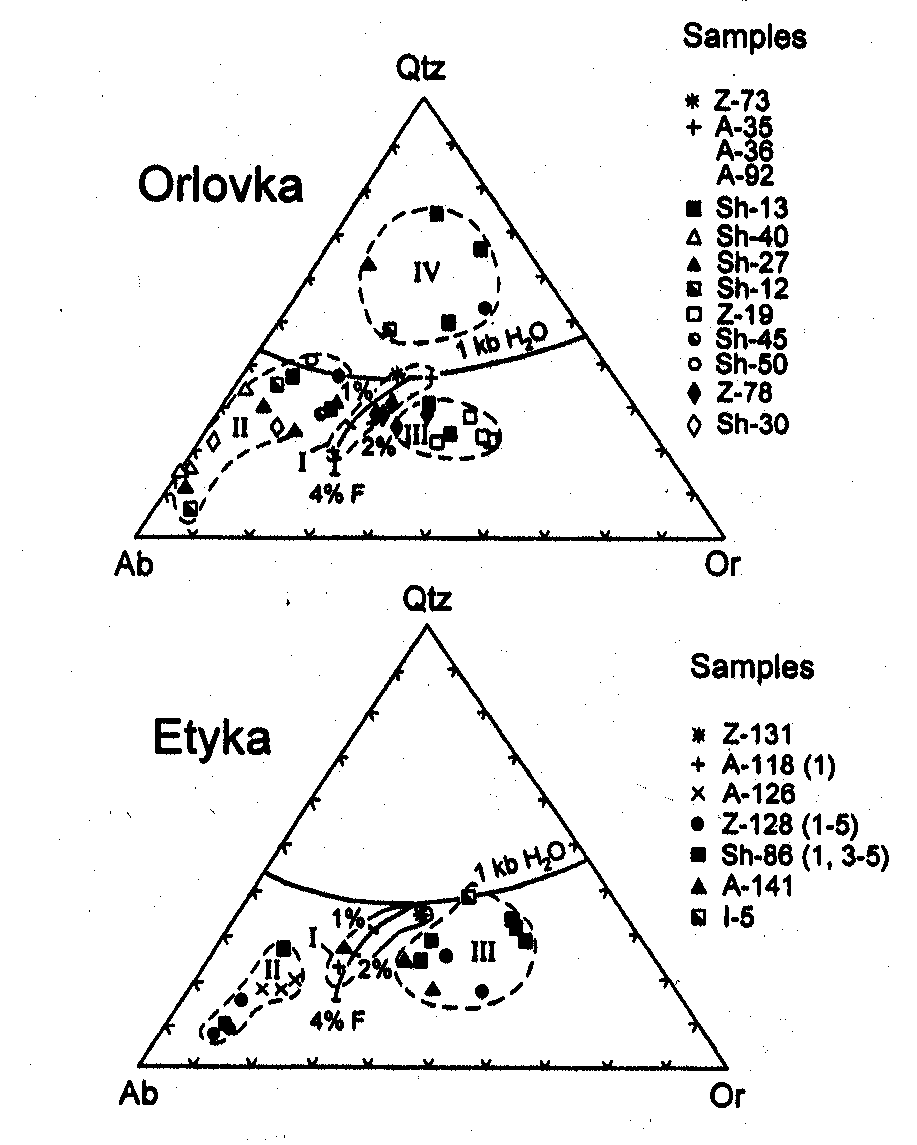
Fig. 1. The normative Otz-Ab-Or compositions of rocks from the Orlovka and Etyka deposits. Fields indicate granites (I), albitite and albitite-aplite (II), quartz-amazonite pegmatite and aplite (III), greisen (IV). Symbols correspond to the composition of granite samples and single layers of banded rocks.
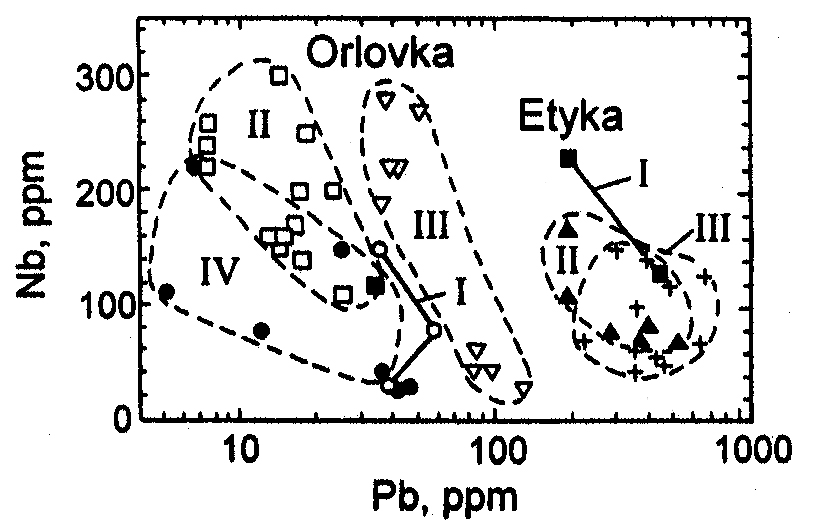
Fig. 2. Nb-Pb variation diagram for the Orlovka and Etyka deposits. Fields I-IV correspond to the rock types from Fig. 1.
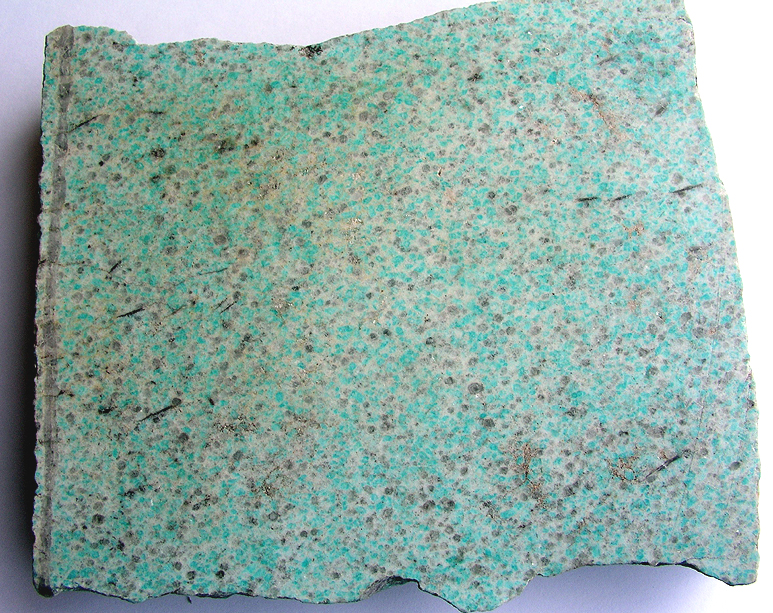
Fig. 3. Fine grained albite-amazonite Li-F granite, Etyka Ta deposit, open pit, level 1136 m, Eastern Transbaikalia.
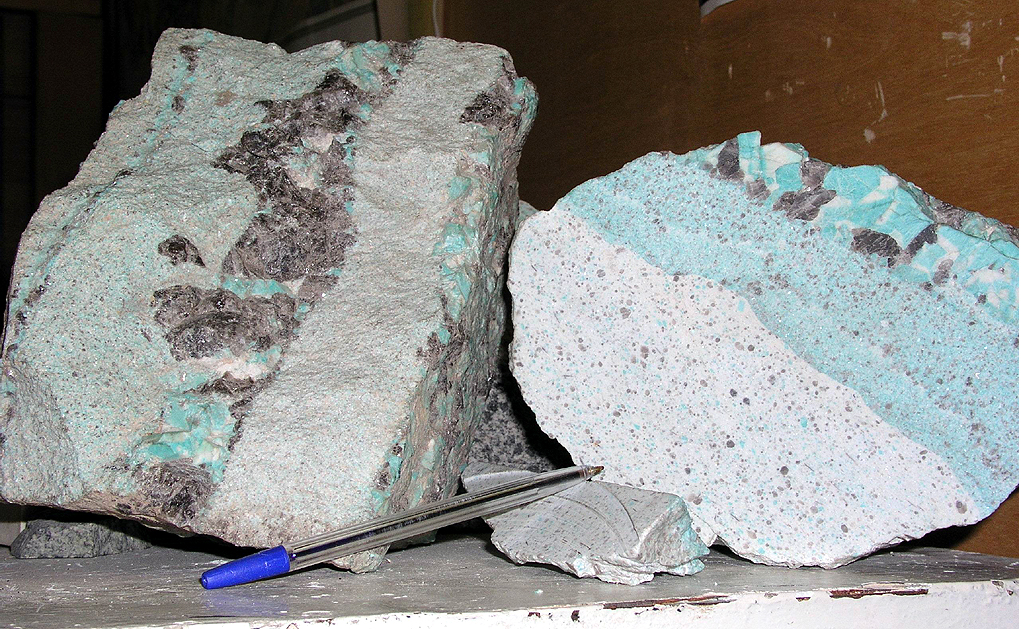
Fig. 4. Veins of quartz-amazonite pegmatite in layered albite-amazonite granite of Etyka, ibid. level 1136 m
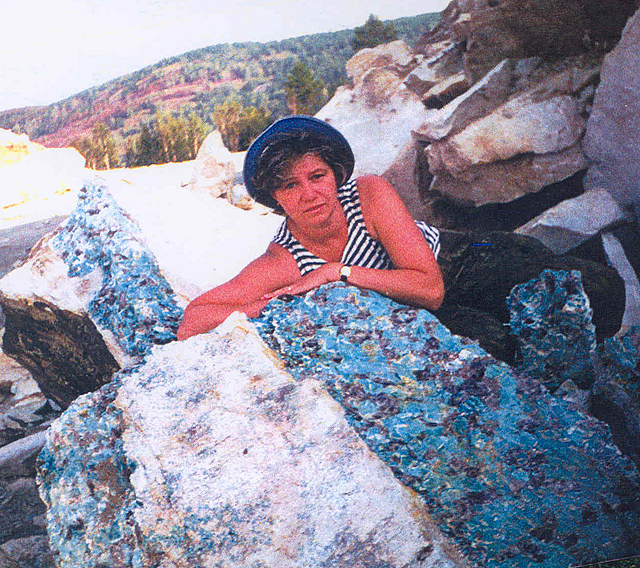
Fig. 5. Veins of quartz-amazonite pegmatite in layered albite-amazonite granite of Etyka, ibid., level 1112 m. Dr. Oxana Udoratina from Syktyvkar penetrates into the mystery of amazonite problem of Etyka.
Table 1. Chemical composition of selected samples from the Orlovka and Etyka tantalum deposits.
|
Oxides, |
Orlovka deposit |
Etyka deposit |
|
Elements |
Z-73 |
A-92 |
Z-5 |
Sh-13/1 |
Z-19/4 |
Sh-13/3 |
Z-131 |
A-118/1 |
Z-112 |
Z-128/4 |
Z-128/3 |
|
SiO2, %
TiO2
Al2O3
Fe2O3
FeO
MnO
MgO
CaO
Na2O
K2O
P2O5
LOI
Total |
73.6
0.24
14.8
0.88
0.69
<0.01
0.48
0.44
3.9
4.3
0.063
0.93
100.2 |
71.2
<0.01
17.0
0.11
0.68
0.079
<0.1
0.085
6.3
4.0
<0.05
0.61
100.2 |
59.9
0.87
17.1
1.7
6.5
0.13
1.1
3.5
5.6
1.9
0.25
1.2
99.8 |
72.5
<0.01
18.0
0.21
0.91
0.17
<0.1
0.25
5.7
1.5
<0.05
1.4
100.4 |
71.4
<0.01
16.0
<0.1
0.66
0.066
<0.1
0.13
4.2
6.7
<0.05
0.62
99.6 |
74.3
<0.01
13.1
1.1
3.3
0.62
<0.1
0.2
0.7
4.3
<0.05
2.3
99.9 |
72.7
0.23
14.7
0.81
0.77
0.04
0.4
0.76
3.7
5.1
0.075
1.0
100.3 |
74.0
0.01
15.4
0.21
0.1
0.028
<0.1
<0.01
6.3
3.9
<0.05
0.31
100.1 |
64.5
0.61
18.6
4.7
nd
0.032
1.5
0.42
2.8
4.6
0.2
2.7
100.6 |
69.2
<0.01
19.6
0.11
<0.1
<0.01
<0.1
<0.01
9.2
1.9
<0.05
0.4
100.5 |
70.7
<0.01
16.9
<0.1
<0.1
<0.01
<0.1
<0.01
3.8
8.3
<0.05
0.29
99.9 |
|
F, ppm
Cl
Li
Rb
Cs
Sr
Ba
Zr
Ta
Nb
W
Mo
Sn
Be
Bi
Cu
Pb
Zn
Ga
La
Y
Yb
Sc
Tl
Ge
Ag
U
V
Cr
Co
Ni |
1300
<50
50
330
18
120
400
160
<100
29
<10
3
10
10
3.1
5
46
50
25
60
25
2
4
6
<2
<0.03
12
25
25
1.5
<3 |
1800
<50
1000
1440
39
4.1
<100
45
200
150
15
<1
25
150
9.8
3
35
150
100
40
3.8
0.6
8
<2
5
0.06
9.9
<3
12
<0.5
<3 |
1200110
110
190
40
200
250
570
<100
23
<10
<1
12
15
<2.5
6
20
200
25
40
68
4
20
<2
2.5
0.08
3.3
60
10
6
<3 |
7900
<50
1100
1010
46
8.6
<100
27
200
200
25
<2
25
20
4.4
8
17
150
100
50
5.2
3
8
<2
20
0.05
<1.5
<3
25
<0.5
3 |
1900
<50
790
2130
43
4.3
<100
11
100
43
<10
4
30
8
80
4
82
80
150
30
5.5
2
2.5
<2
4
0.04
<1.5
<3
15
<0.5
8 |
31600
60
5600
3150
10
6.2
<100
15
150
110
100
<2
120
20
3.3
3
5.1
300
80
<20
2.3
<0.5
10
5
10
0.15
4
<3
10
<0.5
<3 |
3500
50
200
510
39
110
800
170
<100
28
<10
3
120
15
8.9
80
41
80
50
100
23
4
8
<2
<2
0.8
16
60
15
3
5 |
1800
100
740
1760
36
5.8
<100
120
120
230
25
8
1000
12
4.9
4
190
<10
100
<20
3.1
4
2
10
3
4
16
<3
30
<0.5
<3 |
12900
100
260
560
88
130
400
230
<100
18
<10
6
40
20
<2.5
8
17
50
15
40
32
2
8
<2
<2
<0.03
3.1
100
60
4
20 |
2000
50
200
850
15
7.4
<100
9.9
250
71
<10
50
300
20
<2.5
5
290
30
100
<20
1.2
1
<1
5
25
5
207
<3
10
<0.5
<3 |
1900
50
100
3320
50
7.4
<100
9.6
200
150
<10
25
1500
15
<2.5
6
290
<10
80
<20
4.6
2
2.5
40
20
8
13
<3
20
<0.5
4 |
Samples
: Z-73 - subalkali leucogranite of the Khangilai pluton, 5 km NE from the Orlovka deposit; Z-131 - subalkali leucogranite of the Oldanda pluton, 6 km S from the Etyka deposit; A-92, A-118/1 - subalkali Li-F granites; Z-5, Z-112 - host metamorphic schists; Sh-13/1, Z-128/4 -albitites and albitite-aplites; Z-19/4, Z-128/3 - quartz-amazonite pegmatoid and aplite. Sh-13/3 - greisen.
The chemical compositions were analyzed at VSEGEI St. Petersburg by X-ray fluorescence spectrometry (XRF), emission spectrophotometric analysis (ESA), ion selective electrode analysis (ISEA), and flame photometric analysis (FPA).




